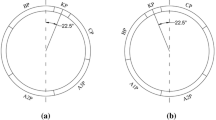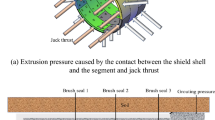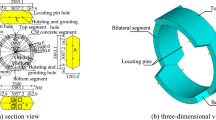Abstract
With the rapid development of the method of shield tunnel in our country, the shield in the tunnel and the internal structure exist a lot of prefabricated and assembled internal structure can be roughly divided into full cast-in-place, full precast, and precast and cast-in-place structure. However, it has the disadvantages of more internal structural joints, poor waterproof performance, and complex structural stress. Therefore, combined with the actual engineering case, the construction process is simulated by using the finite element analysis software, and the influence of the segmental and internal structure cooperative deformation and joint mechanical performance is considered to further analyze the deformation characteristics of shield tunnel assembly internal structure, which can provide a reference for the construction and design of similar projects.
You have full access to this open access chapter, Download conference paper PDF
Similar content being viewed by others
Keywords
1 Introduction
For the past few years, large-diameter shield tunnels have been widely used in the construction of underwater tunnels and tunnels combining highway and metro, such as Nanjing Yangtze River tunnel, Wuhan Sanyang road Yangtze River tunnel, Jinan Yellow River tunnel, etc., because of its efficient utilization of space, high cost-effectiveness and small disturbance to surrounding soil [1, 2]. The internal space layout of shield tunnels presents a variety of ways, but the internal structure of shield tunnels is mainly semi-prefabricated in China [3, 4]. However, few studies on the stress analysis of the fabricated internal structure of shield tunnel at home and abroad, and there is no mature calculation theoretical basis; The construction and service conditions of the prefabricated assembled structure of the fabricated internal structure of large-diameter shield tunnel are also different from those of aboveground buildings [5,6,7]. Its construction technology and environment are more complex, and the requirements for the waterproof and seismic performance of the structure are strict.
Therefore, it is necessary to further study the fabricated internal structure of large-diameter shield tunnels. At present, domestic scholars have studied the assembled underground structure. Tao [8] used ABAQUS software to calculate and study the overall stress and joint deformation of Yuanjiadian subway station of Changchun under different support modes; Taking Guangzhou Metro as an example, Zhang [9] established a three-dimensional coupling model by ABAQUS to study the dynamic response of shield tunnel lining and bolts under train load; Song [10] establishes load structure of multiple subway stations which is used to calculate and analyze the overall deformation, local joint deformation, structural stress and internal force of the fabricated underground station structure; Li [11] used Midas software to analyze and calculate the mechanical performance of arch and rectangular fabricated subway stations respectively, and the results show that the mechanical performance of arch structure stations is better; Li [12] establishes the three-dimensional discontinuous medium of shield segments and bending bolts Qualitative model and reasonable segment joint contact model are set to study the stress and deformation of shield segment under actual load; Liu [13] established joint test model, conducted joint test, and established joint bending stiffness model. The difference between the test value and the calculated value is compared, and the main reasons for this difference are analyzed. In the above research results, the mechanical properties of the prefabricated subway station and shield tunnel lining are analyzed through numerical simulation and full-scale experiment, but the internal structure of shield tunnels is rarely analyzed, and the mechanical characteristics of its internal structure joints are not clear.
Based on the finite element software ABAQUS, a three-dimensional finite element analysis model of soil layer-tunnel-internal structure is established. To provide a reference for the construction and design of similar projects, the deformation rule and internal force characteristics of shield tunnel internal structure under different load grades are systematically compared and studied.
2 Finite Element Model and Parameters
2.1 Model Overview
The segment of a river-crossing tunnel in Shandong Province, a tunnel combing highway and metro, is 2519.2 m long. The segment is made of C60 reinforced concrete, with an outer diameter of 15.2 m.
The ABAQUS finite element software is used to establish the calculation model of soil-tunnel segment-assembled internal structure. The Mohr-Coulomb constitutive model is used for the soil layer and the elastic constitutive model is used for concrete segments and assembled internal structure. Five ring segments are set in the model and five box culverts are set accordingly. The model size is 120 × 75 × 12 m. The soil layer parameters are shown in the following Table 1. The finite element model is shown in Fig. 1. C3D8 element is used for the segment, internal structure, and soil layer. The box culverts are connected by longitudinal connecting bolts which grade is 6.8 with the yield strength of 480 MPa. Assuming that no relative slip and separation occurs between the asphalt concrete pavement and the internal structure, the “Tie” constraint is used between asphalt concrete pavement and internal structures. Static step analysis is used, with fixed constraints at the bottom boundary of the model and horizontal and vertical constraints at both sides of the model.
2.2 Model Parameters
To improve the calculation efficiency, the elastic constitutive model is used for the reinforced concrete segment and the assembled internal structure. The segment is C60 concrete and the internal structure is C40 concrete. The Mohr-Coulomb constitutive model is used for the rock and soil. The basic physical and mechanical parameters of the model are shown in Table 1.
2.3 Cases for Analysis
The construction of internal structures of the tunnel completed is regarded as the initial state of the calculation model after completion of construction. According to the driving positions of the transporting vehicles in the construction stage, the load is simplified into two equal concentrating forces which are applied to the span of the box culvert slab. The load level is divided into 5 levels, which are 100 kN, 150 kN, 200 kN, 250 kN, and 300 kN respectively. The cross section of the loading mode is shown in the following Fig. 2.
3 Result Analysis
3.1 Vertical Displacement Analysis
The displacement curves obtained under the monitoring path are shown in the following Fig. 3(a). Figure 3(b) extracted the vertical displacement values of each key position of the internal structure under different levels of load.
It can be seen from the following drawings that when construction load is applied to the span of the box culvert, the vertical deformation of internal structures mainly concentrates on the span of intermediate box culvert and decreases along the direction of box culvert support, which has an effect on the pre-fabricated lane slab after assembly on both sides. A certain amount of deformation also occurs at the support of the lane slab, and the greater the load level, the more obvious the effect is. With the increase of load grade, the vertical displacement of the key position of the internal structure increases linearly, and the growth rate is the largest at the middle position of the box culvert span. This is caused by the loading position close to the middle of the box culvert span. However, the growth rate of W1 and W2 positions far from the middle position of the box span is small and close.
3.2 Structural Internal Force Analysis
In addition, the response of rebar and connecting bolt of intermediate box culvert is analyzed. Figure 4 shows the rebar and connection bolts maximum principal stress clouds diagram under P = 300 kN. All rebar does not yield. Rebar of the top plate of the box culvert and the upper plate of land are subject to large tensile stress. The maximum principal stress is much lower than the yield strength, which is observed at the bottom of the roof in the loading box culvert with the largest deformation, and the maximum stress is 4.05 Mpa.
3.3 Synergetic Deformation Analysis of Soil-Tunnel Segment-Assembled Internal Structures
Taking the calculation result of load P of 300 kN as an example, the cloud diagram of the calculation result when the loading position is in the middle of the box culvert span is shown as follows. It can be seen that the vertical deformation of the intermediate box culvert mainly concentrates on the box culvert at two coupling points where the load is applied. The maximum vertical displacement of the box culvert span reaches 0.42 mm; The soil-segment-internal structure has a cooperative deformation, and the soil around the segmental also has a certain settlement with the load applied (Figs. 5 and 6).
4 Conclusion
Based on ABAQUS finite element simulation, the simulated stress state is analyzed according to different load sizes. The following conclusions are drawn:
-
(1)
When the inner structure of the shield tunnel is under construction load and the inner structure undergoes non-uniform longitudinal deformation, the box culvert concrete mainly bears tensile stress and the reinforcement and connecting bolts do not yield. When the load is applied, the soil-segment-internal structure synergistically deforms. With the load applied, the soil around the segmental also has a certain amount of settlement.
-
(2)
When the construction load is applied to the middle of the box culvert span, the vertical deformation of the inner structure is mainly concentrated in the box culvert span. With the further construction of the inner structure, the maximum vertical displacement of the box culvert span is 0.4 mm, which indicates that the ability of the assembled inner structure to resist deformation is further improved.
-
(3)
Under different load levels, the vertical displacement in the span of the box culvert increases with the increase of load.
References
Yu, C., Zhou, A.N., Chen, J., et al.: Analysis of a tunnel failure caused by leakage of the shield tail seal system. Undergr. Space 5(2), 105–114 (2020)
Liu, J.W., Shi, C.H., Lei, M.F., et al.: A study on damage mechanism modelling of shield tunnel under unloading based on damage-plasticity model of concrete. Eng. Fail. Anal. 123, 105261 (2021)
Tang, F., He, Y.D.: Research on the internal structures of road - metro shield tunnel. J. Railw. Eng. Soc. 30(12), 57–63 (2013)
Liu, N.: Analysis of and countermeasures against the assembly deviations of prefabri-cated and assembled lane structure in double-deck shield-driven tunnels. Mod. Tunn. Technol. 58(04), 210–217 (2021)
Geng, P., Wang, Q., Guo, X.Y., et al.: Pull-out test of longitudinal joints of shield tunnel. China J. Highw. Transp. 33(07), 124–134 (2020)
Feng, K.: Research on mechanical behavior of segmental lining structure for underwater shield tunnel with large cross-section. Southwest Jiaotong University (2012)
Li, C.L., Wang, G.Q., Zhao, K.J., et al.: Vertical mechanical behavior on shield tunnel under loads on ground surface. J. Jilin Univ. (Eng. Technol. Ed.) 41(S2), 180–184 (2011)
Tao, L.J., Li, Z.Y., Yang, X.R., et al.: Research of the mechanical behaviors of subway station structure assembled with prefabricated elements based on abaqus. Mod. Tunn. Technol. 55(05), 115–123 (2018)
Zhang, B.W.: Dynamic response characteristics analysis of shallow buried shield tunnel segment under-crossing the high speed railway. Railw. Eng. 58(09), 50–54 (2018)
Song, R., Zhang, J.Q., Cui, T., et al.: Analysis on mechanical characteristics of double-span column-free fabricated subway station. Railw. Stan. Des. 65(02), 123–7+78 (2021)
Li, X.H., Liu, C.Y., Liu, B., et al.: Study on bending stiffness of tenon groove joints in a assembled subway station. Constr. Technol. 48(16), 5–7 (2019)
Li, Y.J., He, P., Qin, D.P.: Stress analysis of metro shield tunnel segment. Chin. Civil Eng. J. 44(S2), 131–134 (2011)
Liu, H.M.: Study on the mechanics characters of the fabricated linings in the subway constructed by open-cut method. Southwest Jiaotong University (2003)
Author information
Authors and Affiliations
Corresponding author
Editor information
Editors and Affiliations
Rights and permissions
Open Access This chapter is licensed under the terms of the Creative Commons Attribution 4.0 International License (http://creativecommons.org/licenses/by/4.0/), which permits use, sharing, adaptation, distribution and reproduction in any medium or format, as long as you give appropriate credit to the original author(s) and the source, provide a link to the Creative Commons license and indicate if changes were made.
The images or other third party material in this chapter are included in the chapter's Creative Commons license, unless indicated otherwise in a credit line to the material. If material is not included in the chapter's Creative Commons license and your intended use is not permitted by statutory regulation or exceeds the permitted use, you will need to obtain permission directly from the copyright holder.
Copyright information
© 2022 The Author(s)
About this paper
Cite this paper
Zhu, W., Zhang, X., Zhang, L. (2022). Analysis of Deformation Characteristics of Large Diameter Shield Tunnel with Construction Load. In: Feng, G. (eds) Proceedings of the 8th International Conference on Civil Engineering. ICCE 2021. Lecture Notes in Civil Engineering, vol 213. Springer, Singapore. https://doi.org/10.1007/978-981-19-1260-3_41
Download citation
DOI: https://doi.org/10.1007/978-981-19-1260-3_41
Published:
Publisher Name: Springer, Singapore
Print ISBN: 978-981-19-1259-7
Online ISBN: 978-981-19-1260-3
eBook Packages: EngineeringEngineering (R0)










